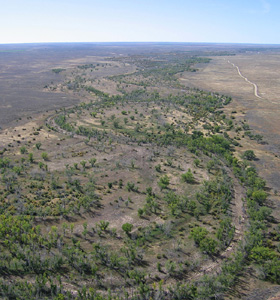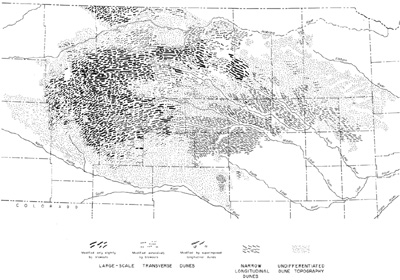
| Central Great Plains
Chapter IV
Emporia State University Emeritus |

| Central Great Plains
Chapter IV
Emporia State University Emeritus |
The Nebraska Sand Hills has been described as resembling a vast sea with gigantic waves frozen in place; the NSH is comparable to other great sand seas in Africa, Arabia, Asia, and Australia. The region remains sparsely populated. Cattle ranching and hay production are the primary land uses based on lush prairie grass and abundant surface water and shallow groundwater. In spite of its austere nature, the NSH has become a destination for ecotourism including hunting, fishing, and bird watching. The sand hills are located along the principal route of the North American central or Great Plains flyway for migrating waterfowl and shorebirds, which find food, shelter, and rest in the myriad wetlands and lakes of the region.

| Animal life in the Nebraska Sand Hills. Cattle grazing in a wet meadow (left). White-faced ibis (Plegadis chihi) stalks through a shallow marsh (right). | 
|
 Return to beginning.
Return to beginning.
 Sketch map of dune types within the Nebraska Sand Hills. Adapted from Keech and Bentall (1978).
| |
Parabolic and barchan dunes of large to intermediate size prevail in the western portion, and small blow-out dunes are found throughout and around the margins of the sand hills. At the boundary between large transverse dunes and barchan dunes, north of Lakeside, a broad valley extends north-south and contains a series of large lakes (see satellite image above). These lakes are drained northward by Pine Creek in a paleovalley that was partly buried by migrating sand dunes.
The dunes appear to have been active several times during the past 10,000 years, most importantly during the mid-Holocene climatic optimum, some 8000 to 5000 years ago, and again from about 3000 to 1500 years ago (Swinehart 1990). Beyond the dune area, wind-blown dust settled over the landscape in a blanket of loess 5 to 20 m thick. The region immediately southeast of the NSH to the Platte River valley has the thickest loess and is known as the Loess Hills. South of the Platte River valley to Kansas, loess thickness diminishes; this region is the Loess Plain (see landscape maps).
Thick dune sand rests on unconsolidated alluvial sand and gravel that cover poorly consolidated Ogallala strata. Extensive test drilling has revealed the great depth of the sub-dune sediments, which locally reach nearly 300 m in thickness. Dune sand is derived from this underlying source, which demonstrates a general principle that wind-blown dunes remain close to the sand source. This great mass of pre-dune sediment was delivered from the Rocky Mountains via rivers that drained across what is now the central and northern NSH. These streams were ancestral to the modern Platte and Niobrara rivers.
 Return to beginning.
Return to beginning.
This immense groundwater reserve is sustained by precipitation that averages about 0.5 m (20 inches) per year through the central portion of the sand hills (Wilhite and Hubbard 1990). Toward the west precipitation declines to less than 17 inches per year, and to the east it increases to more than 22 inches per year. This transition in available water gives rise to different hydrologic zones (see above). In the central and eastern portions, perennial streams display remarkably constant discharge fed by groundwater baseflow; these streams rarely flood or dry up.
Sand hills streams are slightly alkaline (pH 7.7-8.1), low in dissolved solids (100-200 ppm), and low in hardness (Bentall 1990); in order words, excellent water quality. To the north and west, countless shallow lakes occupy enclosed basins. Most of these are slightly alkaline, freshwater lakes associated with extensive marshes and wet meadows that follow elongated swales between large transverse dunes.
 Return to beginning.
Return to beginning.
 Combined references.
Combined references.

 Return to Landscapes table of contents.
Return to Landscapes table of contents.
All text and images © by the authors (2022).